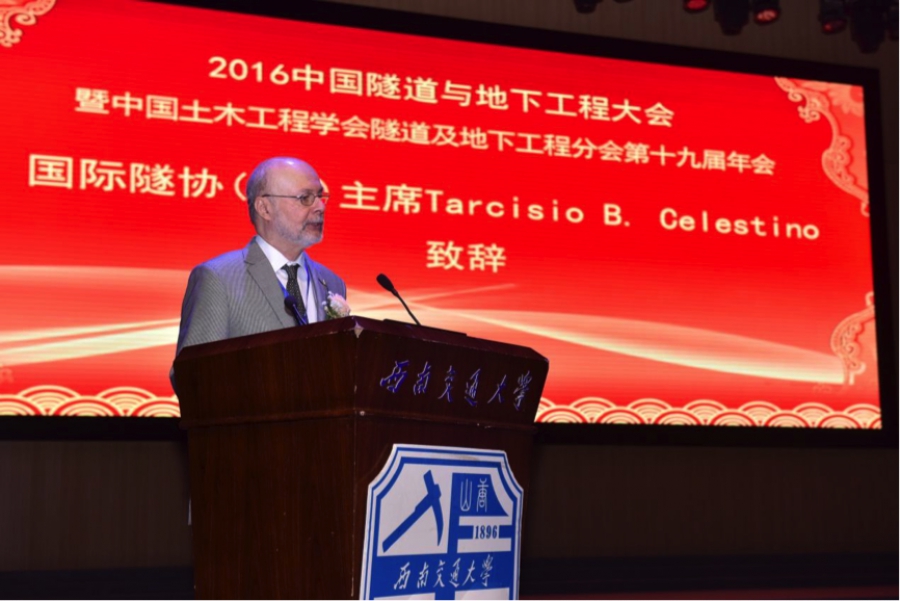More than 1,200 attendees gathered to face the challenges in modern tunnelling
From October 24th to 26th at Southwest Jiaotong University (SWJTU) in Chengdu, the Tunnel and Underground Works Branch of CCES (CCES-TUWB) held China Tunnel and Underground Works Congress 2016, along with its 19th Annual Conference. Choosing “Challenges in Modern Tunnelling” as its theme, this successful international event recorded 1,261 attendees from well-known institutions and enterprises in the industry, with more than 250 participating in the training lecture before the congress.
Supported by International Tunnelling Association (ITA), the congress invited a great number of prestigious experts and personalities as its distinguished guests to participate in this event, including ITA’s president Tarcisio B. Celestino (Brazil); ITA’s former presidents Søren Degn Eskesen (Denmark), In-Mo Lee (Korea), Martin C. Knights (United Kingdom) and Einar Broch (Norway); ITA’s vice president Yan Jinxiu; CCES’s president Guo Yunchong; SWJTU’s president Xu Fei; vice mayor of Chengdu Liu Shoucheng; CCES-TUWB’s president Tang Zhong; academicians of Chinese Academy of Engineering Qian Qihu, Xie Lili, Wang Mengshu, Yang Xiumin, Qian Qingquan, Zhou Fengjun, Zheng Yingren, Liang Wenhao, Yang Yongbin, Du Yanliang, Wang Fuming; academician of Chinese Academy of Sciences Zhai Wanming.
On October 24th, the Opening Ceremony was hosted by Mr. Hong Kairong (CCES-TUWB’s secretary-general and chief engineer of China Railway Tunnel Group Co., Ltd.), during which SWTJU Prof. He Chuan introduced the guests to attendees and SWTJU president Xu Fei addressed the congress, presenting SWTJU’s development strategies and achievements in tunnel and underground works. Mr. Liu Shoucheng, vice mayor of Chengdu, introduced the current status, problems and future plans of rail-transit systems in Chengdu and hoped that each and every expert feel free to give suggestions for the development of tunnel and underground works in Chengdu. ITA’s president Tarcisio B. Celestino expressed his views on the development of tunnel and underground works in China and congratulated beforehand on the success of this event. CCES-TUWB’s president Tang Zhong advised that, with a burgeoning increase of tunnel and underground works in China, more efforts should be put into the tackling of technical challenges encountered.

In the speech of CCES’s president Guo Yunchong, he held that tunnel and underground works is not only an important branch of national infrastructures but also a key discipline in civil engineering, playing an indispensable role in fostering economic and social development and promoting living standards of people. According to the statistics, more than 28,600km tunnels have been built recently in such areas as railroads, highways, hydro-electric infrastructures and city metros, with an increase of 3000-odd km per year. Thanks to that, China has become a “real power in tunnelling” in terms of amount, scale and development speed.
As for the tunneling techniques, a technological system has been established for high-speed railroad tunnels, continuous improvement has been made in techniques for long tunnels built in mountainous areas with complex geological conditions, a great breakthrough has been achieved in techniques for large cross-section tunnels in soft ground, urban large-span shallow tunnels and sub-river tunnels, and great progress has been gained in the R&D and manufacturing of tunnel boring machines, thus displaying that a new high level has been reached in tunneling techniques in China.
In addition to that, more and more attention has been directed to the development and utilization of underground space recently and the amount of underground projects has been increasing in a rapid way, including urban underground rails, underground galleries, underground business districts, underground highways, underground parking lots, underground transportation hubs and underground disaster prevention facilities. Meanwhile, the philosophy for underground development and utilization has shifted a great deal in China, from “being individually built and operated with one single purpose” to “being integrated and comprehensive with multiple purposes”.
On October 25th, the congress offered the attendees one international conference and four technical sessions. On October 26th, there were one brainstorming workshop for graduate students and three technical sessions. Besides, the congress organized visits after the event to Chengdu-Lanzhou Railroad job site, Tibetan Motorway job site, Chengdu Metro, National Key Laboratory for Traction Power/ Ministry of Education Key Laboratory for Tunnel Engineering, and National Civil Engineering Laboratory for Geological Hazards Treatment in Land Transportation.
During the congress, many topics have been addressed with 163 presentations in total consisting of 13 congress presentations, 15 international conference presentations and 135 technical session presentations. The papers collected by the congress amount to 146 , out of which 134 papers have been registered for the congress, including 30 published in the journal Modern Tunnelling Technology and 104 in its supplements. Those congress papers have been compiled and published as a supplement to CCES-TUWB’s journal Modern Tunnelling Technology with a title Proceedings of China Tunnel and Underground Works Congress 2016 and CCES-TUWB 19th Annual Conference.
